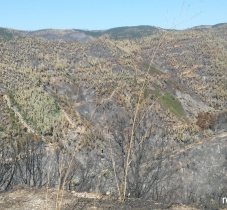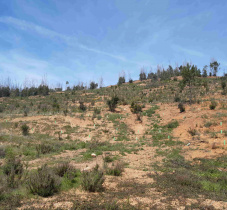Project description
With Reforest'Action and Sylva Nova, take part in an ambitious project to reconstitute the forests burnt by the fire of 2018, which raged in southern Portugal!
The project at a glance
- Number of trees to be planted: 339,459 (over 3 years)
- Area of plantation: 270 hectares
- Species planted: cork oak, faginated oak, white willow, arbutus, eucalyptus.
- Project type: Restoration of a fire-damaged stand
- Planting period: February-March
- Certification: FSC
Context
This ambitious reforestation project takes place in the forest of Algarve that was devasted by a fire in 2018. That year, a long series of raging fires traumatised the inhabitants,the landscape and local economy. The impact of the blazes was amplified by the lack of local resources but also because of unsuitable sylvicultural practices.
These last years, the fires occurring in Portugal were largely mediatized. Yet, a few resources were allocated to the country by international organisations.Today, the authorities and forest owners are more aware of the need to adapt forest management methods to avoid the risks of fires. And for good reason : for a few years, global warming has fueled wildfires in Portugal.
337 399 trees are planted on 270 hectares over 3 years as part of the project, in order to restore the degraded stands. Cork oaks, faggot oaks, white willows,arbutus and eucalyptus are planted at a density of 1,250 trees per hectare to enrich and diversify the traditional stand.
Benefits
-
2019 - 2020 program
2019 marked the beginning of this process of restoration. Exotic species were replaced indigenous ones and in total, 37,284 trees (cork oaks, pin oaks, arbutus and white willows) were planted.
-
2020 - 2021 program
60,115 trees from the same species of cork oak, pin oak, poplar, white willow, some eucalyptus and various forest fruit trees were introduced to the plots.
-
2021-2022 program
The project takes on a new dimension with the ambition of planting 242,060 new trees. This large-scale approach requires the identification of many plots and the expansion of the planting area. This year, the same species are being used,with particular attention paid to cork oak.
Cork oaks, a special asset to boost biodiversity
The cork oak specie has a sparse foliage that allows a large amount of light to pass through. As a result, the lower layers are favoured, which encourages the development of the undergrowth developped. This specie also provided habitat for endangered animals such as the lynx or the Barbary deer, as well as for some birds such as the European cranes.
Planting trees adapted to the local climatic conditions will increase the biodiversity within the plots. It will contribute to limit soil erosion and stabilise the various stands. Over time, this approach will serve the restoration of the various ecosystems and contribute to the fight against climate change.












